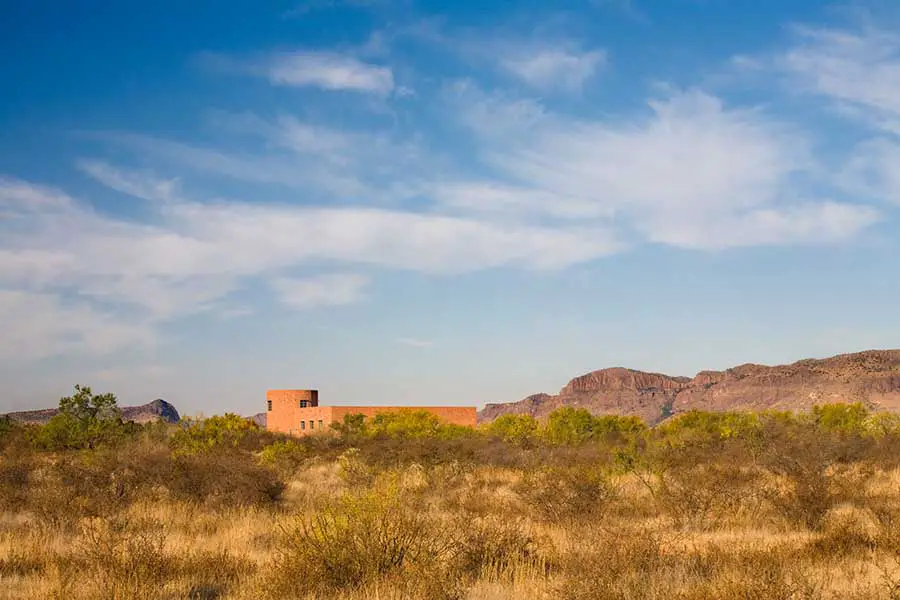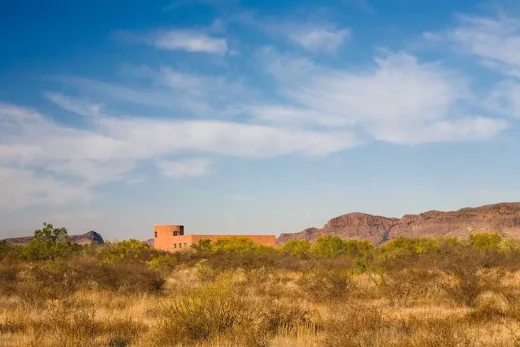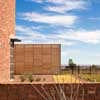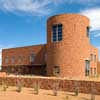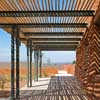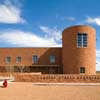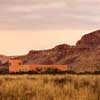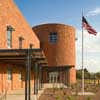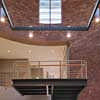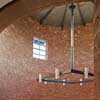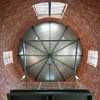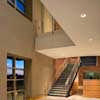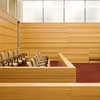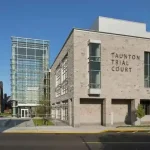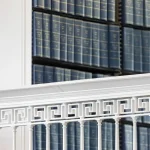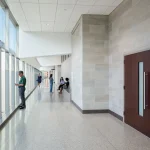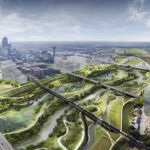Alpine Courthouse photos, West Texan architecture, American architects design, TX court building USA
Alpine Courthouse, west Texas : U.S. District Courthouse
Texan Courthouse Building Development design by PageSoutherlandPage
Dec 13, 2010
Architect: Lawrence W. Speck, FAIA, PageSoutherlandPage
U.S. COURTHOUSE Alpine, Texas
Photos by Chris Cooper
Alpine Courthouse Building
The U.S. Courthouse at Alpine, Texas is a new $13 million, 38,600 GSF, 2-story U.S. District Courthouse facility located on a five-acre site in West Texas. This project was awarded to PageSoutherlandPage through a GSA Design Excellence competition process and synthesizes unique security, sustainability and circulation requirements dictated by the multiple government agencies that inhabit the facility – all while projecting an image of solidity and permanence appropriate for this landmark building in West Texas. The building responds to its region and site, especially the extraordinary quality of the local landscape, the strong and sometimes harsh climate of West Texas and the traditions of civic building in the area.
A Strong Civic Presence
There are few regions in the United States with such a strong tradition of federal government buildings defining the dominant architectural heritage of the place as the Trans-Pecos region. Landmarks like Fort Davis, Fort Stockton, El Fortin del Cibolo and El Fortin de la Cienega in the immediate area are real landmarks of Texas architecture and have served since the early 1850s as emblems of the strength and commitment of the U.S. government here. This new courthouse relates to and continues that tradition.
The simple, economical collection of elemental geometrical forms found in all of these powerful buildings are at work in this new courthouse–from the heavy, durable stonework of Fort Stockton and the officers’ quarters at Fort Davis, to the dominant shading and internal space-making at Cibolo and Fort Davis, to the solid walls punctuated by a landmark tower motif of La Cienega and Cibolo, and finally to the great rotunda form, which comes from many sources in the architectural heritage of the region and public buildings elsewhere.
The Anasazi Indians used the round kiva form for their public meeting spaces long before Europeans came to the desert southwest. El Fortin del Cibolo employs a similar shape centuries later to anchor two corners of the structure. Many civic buildings in Texas, including the State Capitol, use it as an emblem of unity and dignity. It is a timeless and beautiful architectural form, appropriate to the mission of this building.
Landscape Context
Compatibility with the site and the surrounding area takes full account of the Trans-Pecos landscape that dominates the experience of this locale. The building maintains an appropriate frontal relationship to the highway and to the orthogonal grid of Alpine. It sits comfortably between the similarly oriented structures to either side, yet has an appropriately more powerful presence than its neighbors; it is a real landmark for the community at this edge of town. It has the same quality of rising proud and tall from the flat plain as the surrounding hills and mountain ranges.
The materials–primarily russet-colored local West Texas sandstone—link the building to the larger landscape in a powerful way. More than 1200 tons of the stone were laid in a dry-stack configuration by masons that reside in the region. In an area where the nearest industrialized urban area is several hundred miles away, the configuration, materials and construction methods are particularly responsive to the local culture and place.
Landscaping has been carefully designed and selected from the local vegetation with a wide variety of cactus and succulents mixed with some trees in the front of the building complemented by a more intimate and softer selection of landscape in the courtyard. The overall result is a building that seems like it has always been here, working in close harmony with the geology, topography and ecology of its environment.
Sustainability
The masonry walls of the building are an important sustainability feature. They not only employ local labor and a material quarried a short distance from the site, but they also are essential in creating energy savings for the building. Their high thermal mass is effective in dampening the extreme diurnal swing in this high desert environment. Other sustainability features include extensive sun-shading via covered walkways, trellises and horizontal exterior shades on windows, reduced conditioned space by using passively controlled exterior walkways, low- or no-VOC paints and coatings, recyclable carpet and high performance HVAC systems. Interior spaces (including the courtroom itself) have generous daylighting wherever people are working.
Sun shading devices are used above vulnerable windows to the east, south, and west, and generous ramadas, traditional sun shelters in this region, are also employed where effective. The courtyard, another regional climatic control device, is employed to create a shady microclimate adjacent to much of the building’s perimeter. Heating and cooling systems only have to moderate the more temperate courtyard conditions for a large portion of the building’s skin.
Functional Requirements
Because the building’s primary purpose is to provide badly needed space for the federal court to do its business in this part of the country, the goal was to provide a properly functioning courtroom and associated spaces for judges and staff. This included separate facilities for three different groups—judges, prisoners and the public.
All of the primary departments housed in the courthouse have a distinct “front door” on an open covered walkway, which allows people to come and go without traveling through another unit. The walkway surrounds a landscaped courtyard, which creates a sense of intimacy, graciousness and beauty for all units and their visitors. Departmental circulation within the various units is restricted and secure. Last, but not least, the court functions are appropriately elevated to the second floor. A memorable double-height rotunda connects the two floors and provides a dignified, civic feeling for the courts.
Low, unobtrusive stone walls on the public side of the site provide for security through ram protection. A very substantial, blast-resistant masonry wall with protected openings faces the whole site perimeter. But toward the courtyard, much larger and less expensive windows offer soothing vistas and generous daylighting for the offices inside.
Three extra-programmatic spaces were inserted to promote a sense of community in Alpine. A shady trellis on the front of the building offers a place for informal gathering and for modest community events that might benefit from visibility from the street. The cylindrical room inside the entry serves as a space for occasion and ceremony. Its height and dimension give it a feeling of importance, and the extension of a stair landing into the space gives a platform for pronouncements. In a much more intimate way, the courtyard at the center of the building is a place for less structured gathering and interaction.
Lessons learned
1. Remote, rural areas require a rethinking of standard building technologies in order to produce cost-effective buildings.
2. Modern security requirements do not have to generate buildings that are foreign or alienating to their surroundings.
3. Even when design competitions are used as a means to select design teams, it is crucial that there be thorough user input in the subsequent design process.
4. Sustainable design is more than using universal numerical score systems. It requires a careful evaluation of the specific economy, building technologies and climate of a region.
5. Buildings that take full account of their local culture and climate receive a warmer reception from their community.
Alpine Courthouse Building images / information from PageSoutherlandPage
Location: Alpine, Texas, USA
Texan Buildings by PageSoutherlandPage
US Buildings
American Court Building Designs
Taunton Trial Court, MA
Design: Leers Weinzapfel Associates
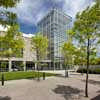
photo : © Anton Grassl / Esto
US District Courthouse in Taunton
Bronx Hall of Justice Building, New York City, NY
Miami Courthouse, Florida
Maricopa Court Building, Phoenix, Arizona
Texan Buildings
Dallas Center for Performing Arts – The Dee and Charles Wyly Theatre
Wyly Theatre Texas
Perot Museum of Nature & Science, Dallas
Perot Museum of Nature & Science Texas
Comments / photos for the Alpine Courthouse Texas – US Court Building design by PageSoutherlandPage Architects page welcome.
Website: https://www.brewstercounty.gov/

